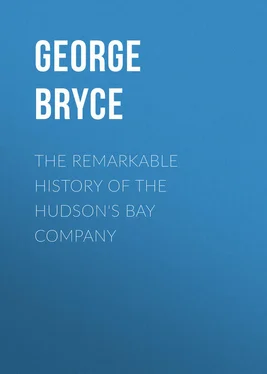George Bryce - The Remarkable History of the Hudson's Bay Company
Здесь есть возможность читать онлайн «George Bryce - The Remarkable History of the Hudson's Bay Company» — ознакомительный отрывок электронной книги совершенно бесплатно, а после прочтения отрывка купить полную версию. В некоторых случаях можно слушать аудио, скачать через торрент в формате fb2 и присутствует краткое содержание. Издательство: Иностранный паблик, Жанр: foreign_antique, foreign_prose, на английском языке. Описание произведения, (предисловие) а так же отзывы посетителей доступны на портале библиотеки ЛибКат.
- Название:The Remarkable History of the Hudson's Bay Company
- Автор:
- Издательство:Иностранный паблик
- Жанр:
- Год:неизвестен
- ISBN:нет данных
- Рейтинг книги:3 / 5. Голосов: 1
-
Избранное:Добавить в избранное
- Отзывы:
-
Ваша оценка:
- 60
- 1
- 2
- 3
- 4
- 5
The Remarkable History of the Hudson's Bay Company: краткое содержание, описание и аннотация
Предлагаем к чтению аннотацию, описание, краткое содержание или предисловие (зависит от того, что написал сам автор книги «The Remarkable History of the Hudson's Bay Company»). Если вы не нашли необходимую информацию о книге — напишите в комментариях, мы постараемся отыскать её.
The Remarkable History of the Hudson's Bay Company — читать онлайн ознакомительный отрывок
Ниже представлен текст книги, разбитый по страницам. Система сохранения места последней прочитанной страницы, позволяет с удобством читать онлайн бесплатно книгу «The Remarkable History of the Hudson's Bay Company», без необходимости каждый раз заново искать на чём Вы остановились. Поставьте закладку, и сможете в любой момент перейти на страницу, на которой закончили чтение.
Интервал:
Закладка:
The earliest name we find this lake known by is that given by Verendrye. He says it was called Lake Minitie (Cree, Ministik) or Des Bois. (1) The former of these names, Minitie, seems to be Ojibway, and to mean Lake of the Islands, probably referring to the large number of islands to be found in the northern half of the Lake. The other name (2), Lac des Bois, or Lake of the Woods, would appear to have been a mistranslation of the Indian (Ojibway) name by which the Lake was known. The name (3) was "Pikwedina Sagaigan," meaning "the inland lake of the sand hills," referring to the skirting range of sand hills running for some thirteen miles along the southern shore of the Lake to the east of the mouth of Rainy River, its chief tributary.
Another name found on a map prepared by the Hudson's Bay Company in 1748 is (4) Lake Nimigon, probably meaning the "expanse," referring to the open sheet of water now often called "La Traverse." Two other names, (5) Clearwater Lake and (6) Whitefish Lake, are clearly the extension of Clearwater Bay, a north-western part of the Lake, and Whitefish Bay, still given by the Indians to the channel to the east of Grande Presqu'île.
On the south-west side of the Lake of the Woods Verendrye's party built Fort St. Charles, probably hoping then to come in touch with the Sioux who visited that side of the lake, and with whom they would seek trade. At this point the prospect was very remote of reaching the Western Sea. The expenses were great, and the fur trade did not so far give sufficient return to justify a further march to the interior. Unassisted they had reached in 1733 Lake Ouinipegon (Winnipeg), by descending the rapid river from Lake of the Woods, to which they gave the name of Maurepas.
The government in Quebec informed the French Minister, M. de Maurepas, that they had been told by the adventurous Jemeraye that if the French King would bear the expense, they were now certain that the Western Sea could be reached. They had lost in going to Lake Ouinipegon not less than 43,000 livres, and could not proceed further without aid. The reply from the Court of France was unfavourable; nothing more than the free privilege of the fur trade was granted the explorers.
In the following year Verendrye built a fort near Lake Ouinipegon, at the mouth of the Maurepas River (which we now know as Winnipeg River), and not far from the present Fort Alexander. The fort was called Fort Maurepas, although the explorers felt that they had little for which to thank the French Minister. Still anxious to push on further west, but prevented by want of means, they made a second appeal to the French Government in 1735. But again came the same reply of refusal. The explorers spent their time trading with the Indians between Lake Winnipeg and Grand Portage, and coming and going, as they had occasion, to Lake Superior, and also to Michilimackinac with their cargoes.
While at Fort St. Charles, on the shores of the Lake of the Woods, in 1736, a great disaster overtook the party. Verendrye's eldest son was very anxious to return to Kaministiquia, as was also the Jesuit priest, Anneau, who was in company with the traders. Verendrye was unwilling, but at last consented. The party, consisting of the younger Verendrye and twenty men, were ruthlessly massacred by an ambush of the Sioux on a small island some five leagues from Fort St. Charles, still known as Massacre Island.
A few days afterwards the crime was discovered, and Verendrye had difficulty in preventing his party from accepting the offer of the Assiniboines and Christinos to follow the Sioux and wreak their vengeance upon them. During the next year Fort Maurepas was still their farthest outpost.
The ruins of Fort St. Charles on the south side of the north-west angle of the Lake of the Woods were in 1908 discovered by St. Boniface Historical Society and the remains of young Verendrye's party found buried in the ruins of the chapel.
Though no assistance could be obtained from the French Court for western discovery, and although the difficulties seemed almost insurmountable, Verendrye was unwilling to give up the path open to him. He had the true spirit of the explorer, and chafed in his little stockade on the shores of Lake Winnipeg, seeking new worlds to conquer.
If it was a great event when Verendrye, in 1731, left the shores of Lake Superior to go inland, it was one of equal moment when, penniless and in debt, he determined at all hazards to leave the rocks and woods of Lake Winnipeg, and seek the broad prairies of the West. His decision being thus reached, the region which is now the fertile Canadian prairies was entered upon.
We are fortunate in having the original journal of this notable expedition of 1738, obtained by Mr. Douglas Brymner, former Archivist at Ottawa. This, with two letters of Bienville, were obtained by Mr. Brymner from a French family in Montreal, and the identity of the documents has been fully established.
This journal covers the time from the departure of Verendrye from Michilimackinac on July 20th, till say 1739, when he writes from the heart of the prairies. On September 22nd the brave Verendrye left Fort Maurepas for the land unknown. It took him but two days with his five men to cross in swift canoes the south-east expanse of Lake Winnipeg, enter the mouth of Red River, and reach the forks of the Red and Assiniboine Rivers, where the city of Winnipeg now stands.
It was thus on September 24th of that memorable year that the eyes of the white man first fell on the site of what is destined to be the great central city of Canada. A few Crees who expected him met the French explorer there, and he had a conference with two chiefs, who were in the habit of taking their furs to the English on Hudson Bay.
The water of the Assiniboine River ran at this time very low, but Verendrye was anxious to push westward. Delayed by the shallowness of the Assiniboine, the explorer's progress was very slow, but in six days he reached the portage, then used to cross to Lake Manitoba on the route to Hudson Bay. On this portage now stands the town of Portage la Prairie.
The Assiniboine Indians who met Verendrye here told him it would be useless for him to ascend the Assiniboine River further, as the water was so low. Verendrye was expecting a reinforcement to join his party, under his colleague, M. de la Marque. He determined to remain at Portage la Prairie and to build a fort. Verendrye then assembled the Indians, gave them presents of powder, ball, tobacco, axes, knives, &c., and in the name of the French King received them as the children of the great monarch across the sea, and repeated several times to them the orders of the King they were to obey.
It is very interesting to notice the skill with which the early French explorers dealt with the Indians, and to see the formal way in which they took possession of the lands visited. Verendrye states that the Indians were greatly impressed, "many with tears in their eyes." He adds with some naïveté , "They thanked me greatly, promising to do wonders."
On October 3rd, Verendrye decided to build a fort. He was joined shortly after by Messrs. de la Marque and Nolant with eight men in two canoes. The fort was soon pushed on, and, with the help of the Indians, was finished by October 15th. This was the beginning of Fort de la Reine. At this stage in his journal Verendrye makes an important announcement, bearing on a subject which has been somewhat discussed.
Verendrye says, "M. de la Marque told me he had brought M. de Louvière to the forks with two canoes to build a fort there for the accommodation of the people of the Red River. I approved of it if the Indians were notified." This settles the fact that there was a fort at the forks of the Red and Assiniboine Rivers, and that it was built in 1738.
In the absence of this information, we have been in the habit of fixing the building of Fort Rouge at this point from 1735 to 1737. There can now be no doubt that October, 1738, is the correct date. From French maps, as has been pointed out, Fort Rouge stood at the mouth of the Assiniboine, on the south side of the river, and the portion of the city of Winnipeg called Fort Rouge is properly named.
Читать дальшеИнтервал:
Закладка:
Похожие книги на «The Remarkable History of the Hudson's Bay Company»
Представляем Вашему вниманию похожие книги на «The Remarkable History of the Hudson's Bay Company» списком для выбора. Мы отобрали схожую по названию и смыслу литературу в надежде предоставить читателям больше вариантов отыскать новые, интересные, ещё непрочитанные произведения.
Обсуждение, отзывы о книге «The Remarkable History of the Hudson's Bay Company» и просто собственные мнения читателей. Оставьте ваши комментарии, напишите, что Вы думаете о произведении, его смысле или главных героях. Укажите что конкретно понравилось, а что нет, и почему Вы так считаете.












